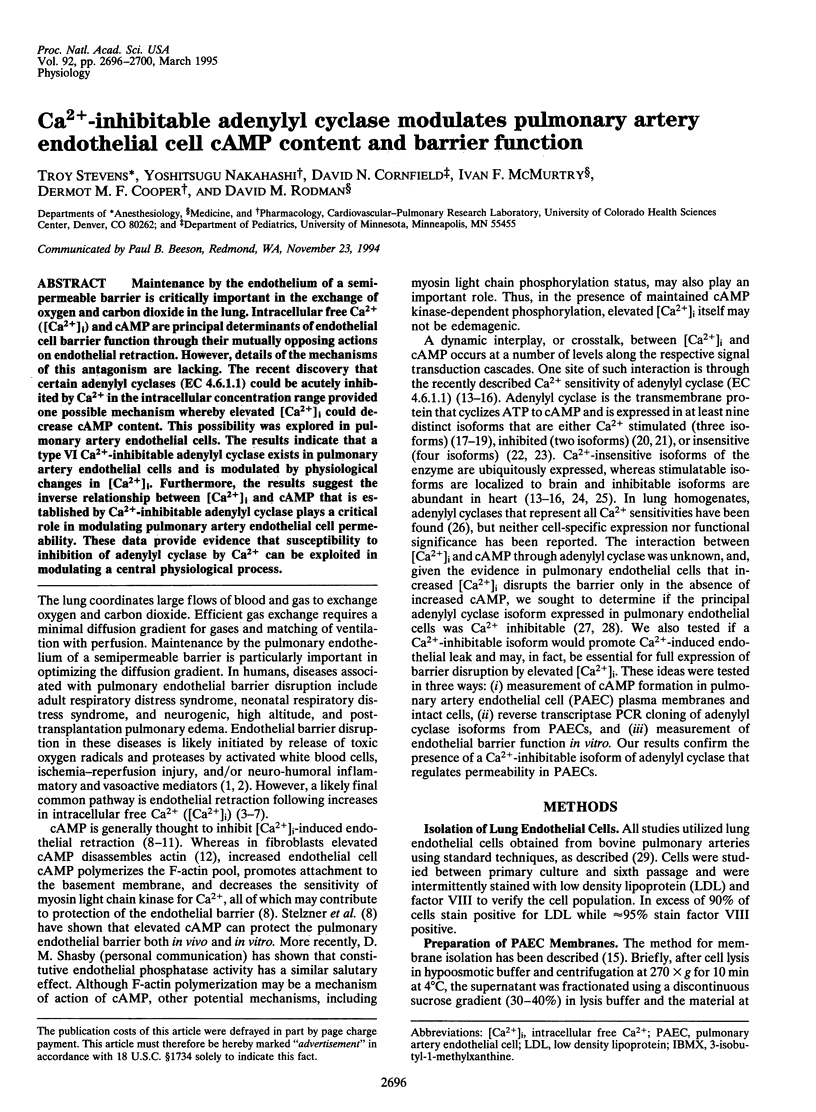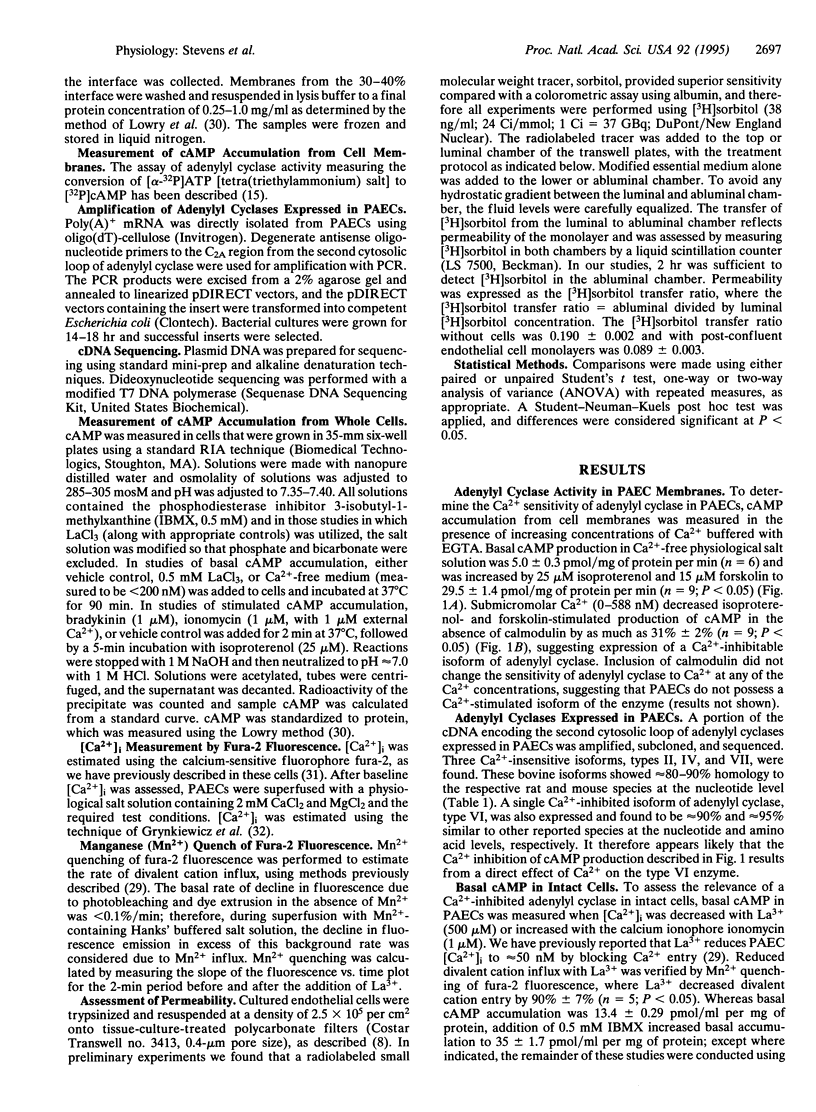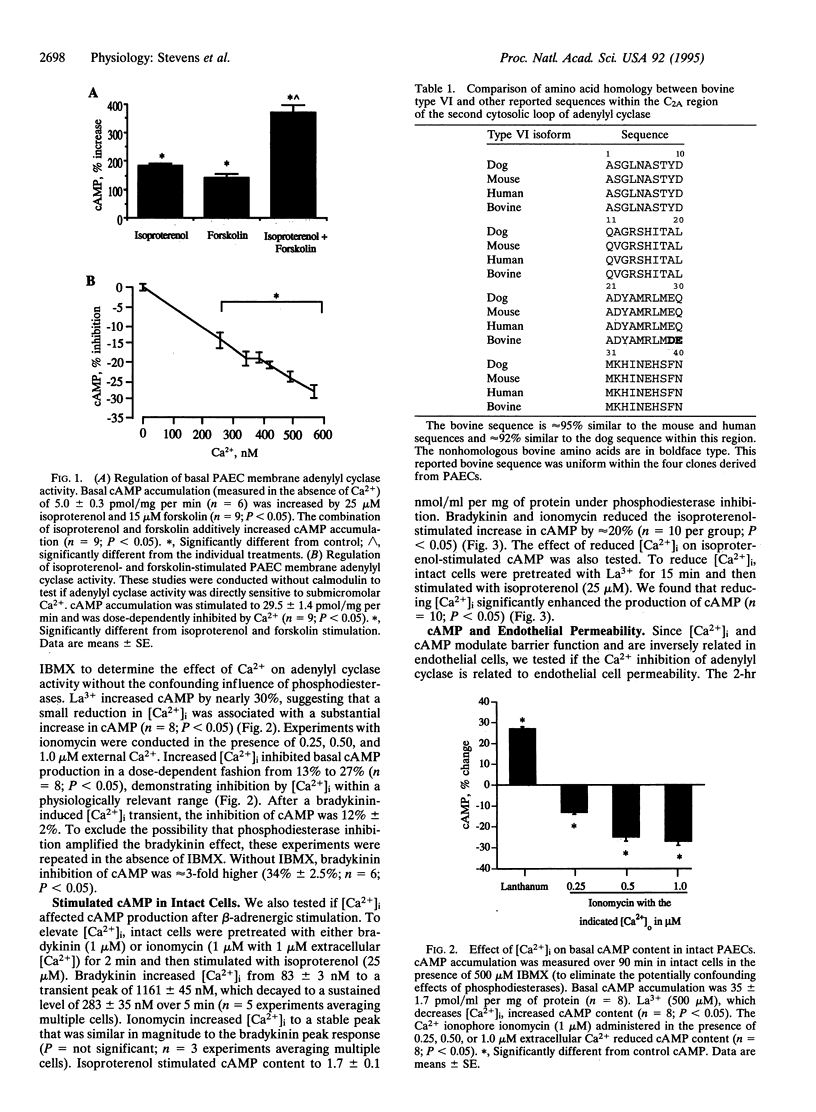Abstract
Maintenance by the endothelium of a semi-permeable barrier is critically important in the exchange of oxygen and carbon dioxide in the lung. Intracellular free Ca2+ ([Ca2+]i) and cAMP are principal determinants of endothelial cell barrier function through their mutually opposing actions on endothelial retraction. However, details of the mechanisms of this antagonism are lacking. The recent discovery that certain adenylyl cyclases (EC 4.6.1.1) could be acutely inhibited by Ca2+ in the intracellular concentration range provided one possible mechanism whereby elevated [Ca2+]i could decrease cAMP content. This possibility was explored in pulmonary artery endothelial cells. The results indicate that a type VI Ca(2+)-inhibitable adenylyl cyclase exists in pulmonary artery endothelial cells and is modulated by physiological changes in [Ca2+]i. Furthermore, the results suggest the inverse relationship between [Ca2+]i and cAMP that is established by Ca(2+)-inhibitable adenylyl cyclase plays a critical role in modulating pulmonary artery endothelial cell permeability. These data provide evidence that susceptibility to inhibition of adenylyl cyclase by Ca2+ can be exploited in modulating a central physiological process.
Full text
PDF




Selected References
These references are in PubMed. This may not be the complete list of references from this article.
- Adkins W. K., Barnard J. W., May S., Seibert A. F., Haynes J., Taylor A. E. Compounds that increase cAMP prevent ischemia-reperfusion pulmonary capillary injury. J Appl Physiol (1985) 1992 Feb;72(2):492–497. doi: 10.1152/jappl.1992.72.2.492. [DOI] [PubMed] [Google Scholar]
- Boyajian C. L., Garritsen A., Cooper D. M. Bradykinin stimulates Ca2+ mobilization in NCB-20 cells leading to direct inhibition of adenylylcyclase. A novel mechanism for inhibition of cAMP production. J Biol Chem. 1991 Mar 15;266(8):4995–5003. [PubMed] [Google Scholar]
- Buchan K. W., Martin W. Modulation of barrier function of bovine aortic and pulmonary artery endothelial cells: dissociation from cytosolic calcium content. Br J Pharmacol. 1992 Dec;107(4):932–938. doi: 10.1111/j.1476-5381.1992.tb13388.x. [DOI] [PMC free article] [PubMed] [Google Scholar]
- Caldwell K. K., Boyajian C. L., Cooper D. M. The effects of Ca2+ and calmodulin on adenylyl cyclase activity in plasma membranes derived from neural and non-neural cells. Cell Calcium. 1992 Feb;13(2):107–121. doi: 10.1016/0143-4160(92)90004-c. [DOI] [PubMed] [Google Scholar]
- Cali J. J., Zwaagstra J. C., Mons N., Cooper D. M., Krupinski J. Type VIII adenylyl cyclase. A Ca2+/calmodulin-stimulated enzyme expressed in discrete regions of rat brain. J Biol Chem. 1994 Apr 22;269(16):12190–12195. [PubMed] [Google Scholar]
- Choi E. J., Xia Z., Storm D. R. Stimulation of the type III olfactory adenylyl cyclase by calcium and calmodulin. Biochemistry. 1992 Jul 21;31(28):6492–6498. doi: 10.1021/bi00143a019. [DOI] [PubMed] [Google Scholar]
- Colvin R. A., Oibo J. A., Allen R. A. Calcium inhibition of cardiac adenylyl cyclase. Evidence for two distinct sites of inhibition. Cell Calcium. 1991 Jan;12(1):19–27. doi: 10.1016/0143-4160(91)90081-o. [DOI] [PubMed] [Google Scholar]
- Cooper D. M., Brooker G. Ca(2+)-inhibited adenylyl cyclase in cardiac tissue. Trends Pharmacol Sci. 1993 Feb;14(2):34–36. doi: 10.1016/0165-6147(93)90027-h. [DOI] [PubMed] [Google Scholar]
- Cooper D. M., Yoshimura M., Zhang Y., Chiono M., Mahey R. Capacitative Ca2+ entry regulates Ca(2+)-sensitive adenylyl cyclases. Biochem J. 1994 Feb 1;297(Pt 3):437–440. doi: 10.1042/bj2970437. [DOI] [PMC free article] [PubMed] [Google Scholar]
- Demirel E., Laskey R. E., Purkerson S., van Breemen C. The passive calcium leak in cultured porcine aortic endothelial cells. Biochem Biophys Res Commun. 1993 Mar 31;191(3):1197–1203. doi: 10.1006/bbrc.1993.1344. [DOI] [PubMed] [Google Scholar]
- Feinstein P. G., Schrader K. A., Bakalyar H. A., Tang W. J., Krupinski J., Gilman A. G., Reed R. R. Molecular cloning and characterization of a Ca2+/calmodulin-insensitive adenylyl cyclase from rat brain. Proc Natl Acad Sci U S A. 1991 Nov 15;88(22):10173–10177. doi: 10.1073/pnas.88.22.10173. [DOI] [PMC free article] [PubMed] [Google Scholar]
- Foy T., Marion J., Brigham K. L., Harris T. R. Isoproterenol and aminophylline reduce lung capillary filtration during high permeability. J Appl Physiol Respir Environ Exerc Physiol. 1979 Jan;46(1):146–151. doi: 10.1152/jappl.1979.46.1.146. [DOI] [PubMed] [Google Scholar]
- Gao B. N., Gilman A. G. Cloning and expression of a widely distributed (type IV) adenylyl cyclase. Proc Natl Acad Sci U S A. 1991 Nov 15;88(22):10178–10182. doi: 10.1073/pnas.88.22.10178. [DOI] [PMC free article] [PubMed] [Google Scholar]
- Giannattasio G., Bianchi R., Spada A., Vallar L. Effect of calcium on adenylate cyclase of rat anterior pituitary gland. Endocrinology. 1987 Jun;120(6):2611–2619. doi: 10.1210/endo-120-6-2611. [DOI] [PubMed] [Google Scholar]
- Grynkiewicz G., Poenie M., Tsien R. Y. A new generation of Ca2+ indicators with greatly improved fluorescence properties. J Biol Chem. 1985 Mar 25;260(6):3440–3450. [PubMed] [Google Scholar]
- He P., Curry F. E. Differential actions of cAMP on endothelial [Ca2+]i and permeability in microvessels exposed to ATP. Am J Physiol. 1993 Sep;265(3 Pt 2):H1019–H1023. doi: 10.1152/ajpheart.1993.265.3.H1019. [DOI] [PubMed] [Google Scholar]
- Ishikawa Y., Katsushika S., Chen L., Halnon N. J., Kawabe J., Homcy C. J. Isolation and characterization of a novel cardiac adenylylcyclase cDNA. J Biol Chem. 1992 Jul 5;267(19):13553–13557. [PubMed] [Google Scholar]
- Krupinski J., Lehman T. C., Frankenfield C. D., Zwaagstra J. C., Watson P. A. Molecular diversity in the adenylylcyclase family. Evidence for eight forms of the enzyme and cloning of type VI. J Biol Chem. 1992 Dec 5;267(34):24858–24862. [PubMed] [Google Scholar]
- Krupinski J. The adenylyl cyclase family. 1991 May 29-Jun 12Mol Cell Biochem. 104(1-2):73–79. doi: 10.1007/BF00229806. [DOI] [PubMed] [Google Scholar]
- LOWRY O. H., ROSEBROUGH N. J., FARR A. L., RANDALL R. J. Protein measurement with the Folin phenol reagent. J Biol Chem. 1951 Nov;193(1):265–275. [PubMed] [Google Scholar]
- Lamb N. J., Fernandez A., Conti M. A., Adelstein R., Glass D. B., Welch W. J., Feramisco J. R. Regulation of actin microfilament integrity in living nonmuscle cells by the cAMP-dependent protein kinase and the myosin light chain kinase. J Cell Biol. 1988 Jun;106(6):1955–1971. doi: 10.1083/jcb.106.6.1955. [DOI] [PMC free article] [PubMed] [Google Scholar]
- Lynch J. J., Ferro T. J., Blumenstock F. A., Brockenauer A. M., Malik A. B. Increased endothelial albumin permeability mediated by protein kinase C activation. J Clin Invest. 1990 Jun;85(6):1991–1998. doi: 10.1172/JCI114663. [DOI] [PMC free article] [PubMed] [Google Scholar]
- Minnear F. L., DeMichele M. A., Moon D. G., Rieder C. L., Fenton J. W., 2nd Isoproterenol reduces thrombin-induced pulmonary endothelial permeability in vitro. Am J Physiol. 1989 Nov;257(5 Pt 2):H1613–H1623. doi: 10.1152/ajpheart.1989.257.5.H1613. [DOI] [PubMed] [Google Scholar]
- Nuytinck J. K., Goris R. J., Weerts J. G., Schillings P. H., Stekhoven J. H. Acute generalized microvascular injury by activated complement and hypoxia: the basis of the adult respiratory distress syndrome and multiple organ failure? Br J Exp Pathol. 1986 Aug;67(4):537–548. [PMC free article] [PubMed] [Google Scholar]
- Rotrosen D., Gallin J. I. Histamine type I receptor occupancy increases endothelial cytosolic calcium, reduces F-actin, and promotes albumin diffusion across cultured endothelial monolayers. J Cell Biol. 1986 Dec;103(6 Pt 1):2379–2387. doi: 10.1083/jcb.103.6.2379. [DOI] [PMC free article] [PubMed] [Google Scholar]
- Schaeffer R. C., Jr, Gong F., Bitrick M. S., Jr, Smith T. L. Thrombin and bradykinin initiate discrete endothelial solute permeability mechanisms. Am J Physiol. 1993 Jun;264(6 Pt 2):H1798–H1809. doi: 10.1152/ajpheart.1993.264.6.H1798. [DOI] [PubMed] [Google Scholar]
- Seibert A. F., Thompson W. J., Taylor A., Wilborn W. H., Barnard J., Haynes J. Reversal of increased microvascular permeability associated with ischemia-reperfusion: role of cAMP. J Appl Physiol (1985) 1992 Jan;72(1):389–395. doi: 10.1152/jappl.1992.72.1.389. [DOI] [PubMed] [Google Scholar]
- Shasby D. M., Lind S. E., Shasby S. S., Goldsmith J. C., Hunninghake G. W. Reversible oxidant-induced increases in albumin transfer across cultured endothelium: alterations in cell shape and calcium homeostasis. Blood. 1985 Mar;65(3):605–614. [PubMed] [Google Scholar]
- Siflinger-Birnboim A., Bode D. C., Malik A. B. Adenosine 3',5'-cyclic monophosphate attenuates neutrophil-mediated increase in endothelial permeability. Am J Physiol. 1993 Feb;264(2 Pt 2):H370–H375. doi: 10.1152/ajpheart.1993.264.2.H370. [DOI] [PubMed] [Google Scholar]
- Siflinger-Birnboim A., Goligorsky M. S., Del Vecchio P. J., Malik A. B. Activation of protein kinase C pathway contributes to hydrogen peroxide-induced increase in endothelial permeability. Lab Invest. 1992 Jul;67(1):24–30. [PubMed] [Google Scholar]
- Stelzner T. J., O'Brien R. F., Sato K., Weil J. V. Hypoxia-induced increases in pulmonary transvascular protein escape in rats. Modulation by glucocorticoids. J Clin Invest. 1988 Dec;82(6):1840–1847. doi: 10.1172/JCI113800. [DOI] [PMC free article] [PubMed] [Google Scholar]
- Stevens T., Cornfield D. N., McMurtry I. F., Rodman D. M. Acute reductions in PO2 depolarize pulmonary artery endothelial cells and decrease [Ca2+]i. Am J Physiol. 1994 Apr;266(4 Pt 2):H1416–H1421. doi: 10.1152/ajpheart.1994.266.4.H1416. [DOI] [PubMed] [Google Scholar]
- Stevens T., Fouty B., Cornfield D., Rodman D. M. Reduced PO2 alters the behavior of Fura-2 and Indo-1 in bovine pulmonary artery endothelial cells. Cell Calcium. 1994 Nov;16(5):404–412. doi: 10.1016/0143-4160(94)90033-7. [DOI] [PubMed] [Google Scholar]
- Tang W. J., Krupinski J., Gilman A. G. Expression and characterization of calmodulin-activated (type I) adenylylcyclase. J Biol Chem. 1991 May 5;266(13):8595–8603. [PubMed] [Google Scholar]
- Yoshimura M., Cooper D. M. Cloning and expression of a Ca(2+)-inhibitable adenylyl cyclase from NCB-20 cells. Proc Natl Acad Sci U S A. 1992 Aug 1;89(15):6716–6720. doi: 10.1073/pnas.89.15.6716. [DOI] [PMC free article] [PubMed] [Google Scholar]


